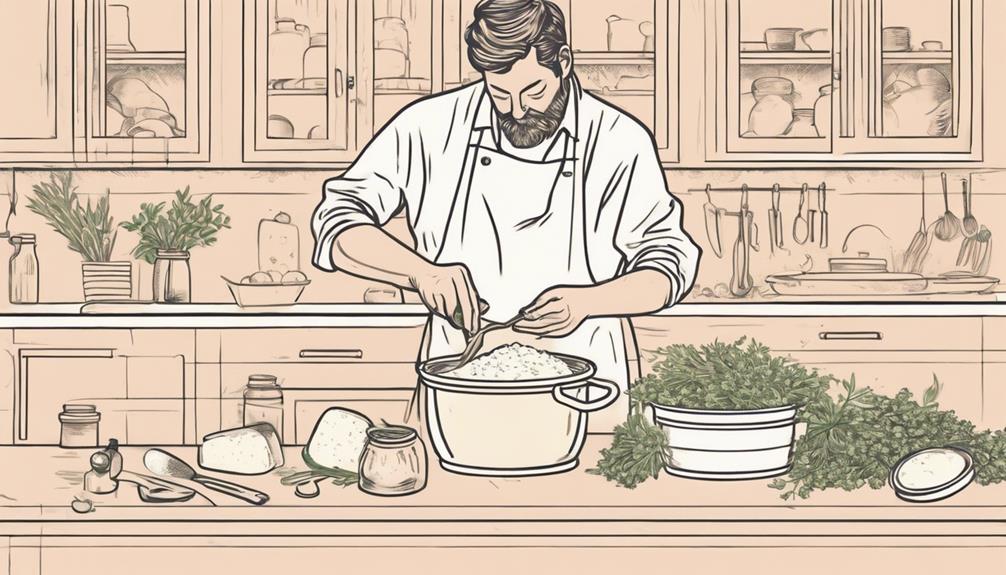See All: Cheese Making
Watch How To Do This Here…
YES! You can make cheese at home. Take our FREE 4-Part video training series to simplify cheesemaking for everyone. No waste. No overwhelm. No missing steps. You can make delicious, healthy cheese, even if you only have access to grocery store milk and regular kitchen equipment…
Click Here To Watch Step By Step Now
“I’ve recently started cheesemaking as a hobby here in Vancouver, Canada, and I’ve been reading up on curd knitting but I’m still a bit confused about what it actually involves and why it’s so important. Can you explain this in more detail?” Cheers, David, Vancouver, Canada.
What’s Curd Knitting, And Why Is It Important?
Hey David! So, you’ve ventured into the wonderful world of cheesemaking! That’s awesome. Let’s chat about curd knitting, a term that might sound a bit strange but is super important in making great cheese.
What is Curd Knitting?
Curd knitting, in cheesemaking lingo, is the process where curds come together to form a cohesive mass after they’ve been cut and partially drained of whey. Think of it like weaving or knitting fabrics together, but here, it’s curds that are melding into a lovely, unified block.
How Does Curd Knitting Work?
When you add rennet to the milk, it coagulates, forming curds. Once you’ve cut the curds, you usually cook them gently and stir them for a while. This helps them shrink and lose more whey. As you cook and stir, the curds start to expel whey and gradually come together. It’s almost like they are knitting themselves into a cohesive piece.
The crucial factors influencing this process are:
- Temperature: It needs to be just right. Too hot, and you end up with rubbery cheese. Too cold, the curds won’t knit properly.
- pH Levels: Achieving the optimal acidity is crucial. If the pH is off, the curds won’t knit together correctly.
- Stirring Technique: Gentle and consistent stirring helps facilitate the knitting process.
Why is Curd Knitting Important?
The importance of curd knitting can’t really be overstated, David. Here are some key reasons:
Texture
A well-knitted curd mass ensures a uniform and smooth texture. Think of your favorite aged cheddar or gouda – without proper curd knitting, you’d never get that smooth, enjoyable mouthfeel.
Flavor Development
Uniform knitting of the curds helps even out moisture content, aiding in consistent aging. A well-knitted curd mass allows the cheese to develop a deeper, more uniform flavor profile. This consistency aids in the overall ripening process, ensuring that the flavors mature harmoniously.
Aesthetic Appeal
This might seem minor, but a well-knitted curd gives the cheese a pleasing appearance. Whether you’re making cheese at home or potentially selling it, presentation matters.
Practical Tips for Achieving Great Curd Knitting
Let’s get to some practical advice so you can ace your curd knitting. This will make a big difference in the cheeses you’ll be making in Vancouver, David.
Maintain Ideal Temperature
- Heat the curds slowly and steadily. A sudden increase in temperature can cause uneven knitting.
- Use a thermometer to monitor the temperature closely. Most cheeses require a gradual increase in temperature – typically around 2-3 degrees Celsius over several minutes.
Monitor pH Levels
Invest in a good pH meter. Most cheeses have a target pH level for optimal curd knitting. For example, a pH of around 6.2-6.4 is ideal for cheddar before draining the whey.
Gentle Stirring
- Stir consistently but gently to prevent the curds from breaking apart too much. Too vigorous stirring leads to grainy texture.
- Use a slotted spoon or a similar tool to stir. This helps distribute heat evenly and supports uniform whey expulsion.
Draining and Pressing
Once the curds are sufficiently knitted, it’s time to drain the whey completely. Pressing the curds further aligns the curds, squeezing out the remaining whey and solidifying the mass.
Examples of Well-Knitted Cheeses
Several cheeses showcase the benefits of well-executed curd knitting:
- Cheddar: Characterized by its dense, cohesive texture. Perfect curd knitting is essential to achieve its signature smoothness and durability.
- Gouda: Its creamy texture and uniform consistency owe a lot to effective curd knitting.
- Swiss (Emmental): This cheese, with its iconic holes, requires precise curd knitting to balance between firmness and elasticity.
Potential Pitfalls and How to Avoid Them
Let’s go through some common challenges you might face with curd knitting and how to overcome them:
Curds Not Knitting Together
This could happen if the pH levels are off, the temperature is too low or high, or stirring wasn’t consistent. Double-checking your process and measurements can help address this.
Curds Too Dry or Too Moist
If curds are too dry, they won’t knit well and can result in crumbly cheese. On the other hand, overly moist curds can lead to a cheese that doesn’t hold together. Adjust your cooking time and whey drainage accordingly.
Inconsistent Texture
This results from uneven heating or improper stirring. Make sure to follow recipe guidelines closely, especially during the heating stage.
David, these pointers should help you get a grip on curd knitting, enhancing your cheesemaking skills and giving you fantastic results. Keep an eye on the details, and you’ll be savoring delightful, homemade cheese in no time!
Final Thoughts…
David, thanks for sending in this great question from Vancouver. In a nutshell, curd knitting is all about ensuring your curds form a unified and cohesive mass, influencing the texture, flavor, and appearance of your cheese. Perfect temperature control, monitoring pH levels, and gentle stirring are your best friends here. Enjoy your cheesemaking journey!
Return To: Cheese Making
Free Step By Step Cheese Making Videos…
YES! You can make cheese at home. Take our FREE 4-Part video training series to simplify cheesemaking for everyone. No waste. No overwhelm. No missing steps. You can make delicious, healthy cheese, even if you only have access to grocery store milk and regular kitchen equipment…

